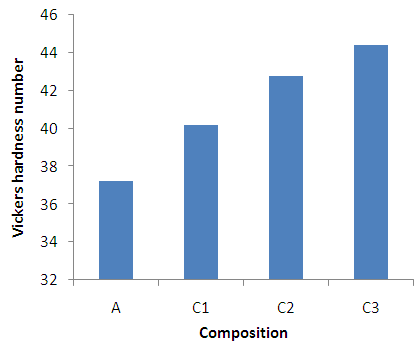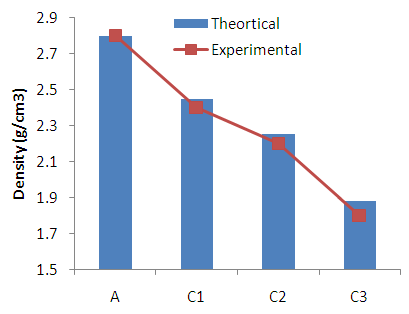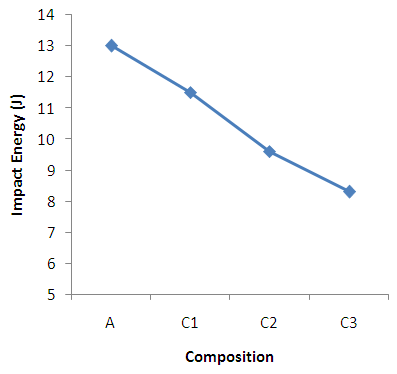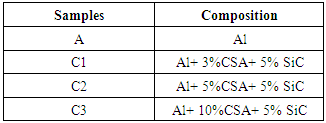-
Paper Information
- Next Paper
- Previous Paper
- Paper Submission
-
Journal Information
- About This Journal
- Editorial Board
- Current Issue
- Archive
- Author Guidelines
- Contact Us
American Journal of Materials Science
p-ISSN: 2162-9382 e-ISSN: 2162-8424
2017; 7(4): 112-115
doi:10.5923/j.materials.20170704.09

Effect of Coconut Shell Ash and SiC Particles on Mechanical Properties of Aluminium Based Composites
Poornesh M., Johnson Xavier Saldanha, Jevy Singh, Gavin Manuel Pinto, Gaurav
Department of Mechanical Engineering, St Joseph Engineering College, Vamanjoor, Mangaluru
Correspondence to: Poornesh M., Department of Mechanical Engineering, St Joseph Engineering College, Vamanjoor, Mangaluru.
| Email: |  |
Copyright © 2017 Scientific & Academic Publishing. All Rights Reserved.
This work is licensed under the Creative Commons Attribution International License (CC BY).
http://creativecommons.org/licenses/by/4.0/

In the present work, an effort has been made to study about the properties of the composites prepared by reinforcing pure aluminium metal with varying percentage of Coconut Shell Ash and SiC particles. The composites were prepared using stir casting process with bottom pouring at a pre-set melting temperature and stirring speed. The produced composites were then studied for mechanical properties like hardness, density etc. It was noticed from the results, that the inclusion of ash and ceramic particles has a significant influence on the mechanical properties but will make the composites brittle.
Keywords: Aluminium Composites, Coconut Shell Ash, SiC particles, Stir Casting
Cite this paper: Poornesh M., Johnson Xavier Saldanha, Jevy Singh, Gavin Manuel Pinto, Gaurav, Effect of Coconut Shell Ash and SiC Particles on Mechanical Properties of Aluminium Based Composites, American Journal of Materials Science, Vol. 7 No. 4, 2017, pp. 112-115. doi: 10.5923/j.materials.20170704.09.
Article Outline
1. Introduction
- The synthesis and characterization of a wide array of Aluminium based composites has unremitting to engender a lot of attention adjudicating from the large volume of publications in this area of materials science and engineering for the past thirty years [1]. This is owing to the versatile applications Al based composites have been efficaciously utilized in and the huge prospects it has for so many other new applications. From the development of high performance components for automobile, aerospace, defence, marine and other notable industrial applications to the development of facilities for sports and recreation, the areas of application of Al based composites is expected to still continue to grow.Metal matrix composites (MMCs) hold significantly enhanced properties comprising of high specific strength, specific modulus, damping capacity and good wear resistance compared to unreinforced alloys [2]. Similarly, there has been an increasing interest in composites containing low density and low cost reinforcements. Among various discontinuous dispersions used are fly ash, red mud, Rice husk ash are some of the most inexpensive and low density reinforcement available in large quantities as solid waste by- product.Coconut shell has diminutive or no economic value but they are appropriate for preparation of carbon black due to its outstanding natural structure and low ash content [3]. At present, the Nigeria coconut shell is recycled as a source of fuel for the boilers, and residual coconut shell is disposed off as gravel for plantation roads maintenance. Black smiths also purchase the coconut shell as fuel material in their casting and forging operations. Therefore, the objective of this current work is to characterize coconut shell in order to discover its usage in metal matrix composites.In the work conducted by J W Pinto et al [4] when Coconut Shell Ash and E-fiber were reinforced with Al-6061 alloy using the stir casting technique, an appreciable increase in various mechanical properties like micro hardness and Ultimate Tensile strength was noticed. Moreover, the triobogical property i.e. the specific wear rate showed a decreasing trend with the increase of the reinforcements. Prakash Kumar Dalai et al [5] studied about the influence of machining process parameters of agro waste reinforced aluminium metal matrix composites. They clearly stated that, the introduction of agricultural wastes like flyash and coconut shell ash has increased the hardness and tensile strength of prepared composites. The silicon content present in the ash has helped in increased in the strength of the composites but when the amount of ash was increased the ductility of the specimen decreased. The cutting forces involved showed a decreasing trend with the increase of cutting speed. M P Navin et al [6] investigated about the changes in the properties of the Al 360 alloy when it was reinforced with Coconut Shell Ash and SiC particles. The composites was prepared using stir casting technique with various proportions of the reinforcements and were tested for hardness and tribological properties so that it can be used for clutch plate. It was observed that, the hardness of the composite prepared using the coconut shell ash was lower than that of the base alloy but with the addition of SiC particles a considerable increase in the hardness was obtained. The coefficient of friction and the wear resistance was found to be increasing with increase of SiC content in the composite. Ankesh Kumar et al [7] inspected the physical, mechanical and tribological properties of aluminium with coconut shell ash. The density and the hardness of the samples revealed that with the increase of percentage of ash in the matrix reduced the density but increased the hardness of the composites. The machining parameters like depth of cut, speed and feed rate against the surface roughness was compared and the reinforced composites exhibited better properties than the unreinforced base alloy.
2. Experimental Details
- The present study was conducted by reinforcing the commercially available pure aluminium metal with various percentages of Coconut Shell Ash and SiC particles to form hybrid metal matrix composites. The Coconut Shell Ash particles employed for the preparation of the composites had a particle size varying from 50-60μm whereas the SiC particles added was ranging from 40-60μm. The composition of the Coconut Shell Ash is given in Table 1.
|
|
3. Results and Discussion
3.1. Hardness
 | Figure 1. Comparison of hardness for different composition of coconut shell ash and silicon carbide |
3.2. Density
 | Figure 2. Comparison of density for different composition of coconut shell ash and silicon carbide |
3.3. Impact Test
 | Figure 3. Comparison of Impact Energy for different composition of coconut shell ash and silicon carbide |
3.4. Tensile Test
 | Figure 4. Comparison of Impact Energy for different composition of coconut shell ash and silicon carbide |
4. Conclusions
- The following conclusions can be drawn from the present study:i. The composite was successfully cast using the stir casting technique under a teeming temperature of 750°C and a stirring speed of 600 rpm.ii. From the results of Vickers Hardness Test, it was noticed that inclusion of reinforcing particles has helped in increasing the hardness of the composites. A significant increase from 37 HV to 44 HV was found when the composite was reinforced with 10% of CSA and 5% of SiC.iii. The impact energy as well as the density of the composites exhibited an decreasing trend in the result because of the inherent properties demonstrated by the additives. iv. The tensile tests results revealed that, with the increase of the reinforcements in the matrix material, the UTS increases. However, increase of the reinforcing particles slowly decreases the brittleness of the composite.
ACKNOWLEDGEMENTS
- The authors are grateful to the management of St Joseph Engineering College, Vamanjoor, Mangaluru and Nitte Meenakshi Institute of Technology, Bengaluru for allowing us to use the facility from the research centre for the completion of this study.
 Abstract
Abstract Reference
Reference Full-Text PDF
Full-Text PDF Full-text HTML
Full-text HTML
